
Ablaze: A fleet of tugs attempt to extinguish the fire on the sinking oil rig Deepwater Horizon, off Louisiana
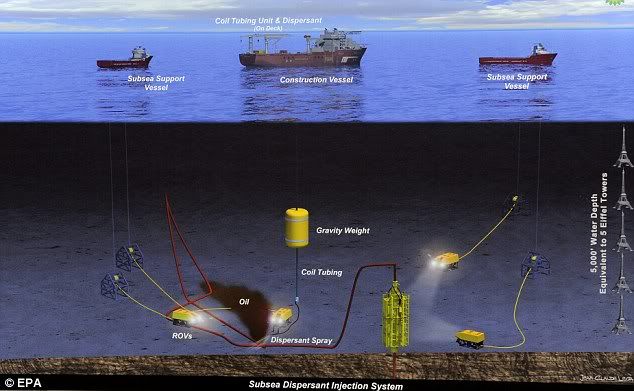
Efforts to stem the flow: A Subsea Dispersant Injection System will be deployed by BP to contain oil below the surface of the Gulf of Mexico

Fishermen listen as a BP company representative outlines a plan to clean up the oil spill which threatens their livelihoods
BP is facing a £3billion fine for the oil spill on America’s Gulf Coast which is threatening to become the worst ecological disaster in history - and is now under fire for not foreseeing the catastrophe.
Documents emerged yesterday showing BP had previously downplayed the possibility of a catastrophic accident at the rig.
It suggested in a 2009 exploration plan and environmental impact analysis for the well that an accident leading to a giant oil spill – and damage to beaches, fish and animals – was unlikely or virtually impossible.
The plan for the Deepwater Horizon well, filed with the Federal Minerals Management Service, said repeatedly that it was ‘unlikely that an accidental surface or subsurface oil spill would occur from the proposed activities’.
BP conceded a spill would impact on beaches, wildlife refuges and wilderness areas but argued that ‘due to the distance to shore (48 miles) and the response capabilities that would be implemented, no significant adverse impacts are expected’.
Environmental lawyer Robert Wiygul said he saw nothing in the document suggesting that BP had addressed the technology needed to control a spill at such a depth.
‘The point is, if you’re going to be drilling in 5,000 feet of water for oil, you should have the ability to control what you’re doing,’ he said.
Two dozen lawsuits have been filed in the US accusing BP of lying about safety plans and downplaying the likelihood of a catastrophe.
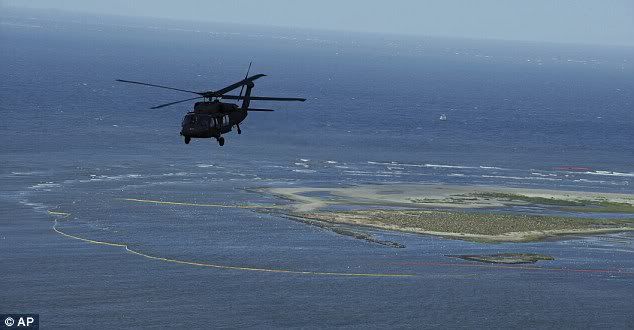
Hopeless: A helicopter flies over an oil boom ringing the islands of the Mississippi delta on Thursday
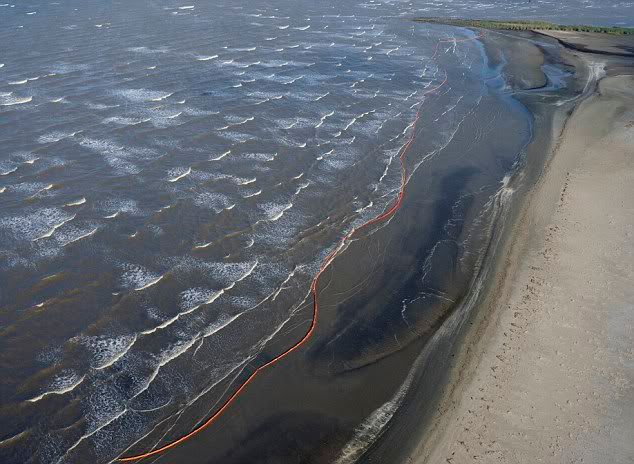
No way to stop it: Rough winds and waves push against an oil boom set up in a flimsy effort to protect the Louisiana coast
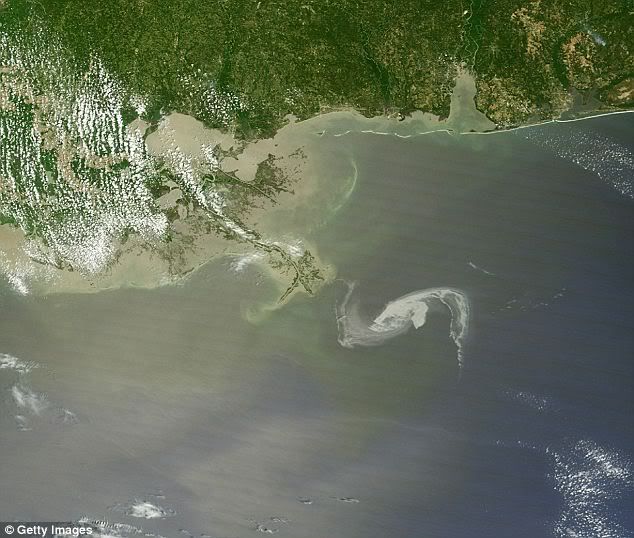
Closing in: The oil slick (the white swirl just off the coastline) nears Louisiana in this Nasa satellite image
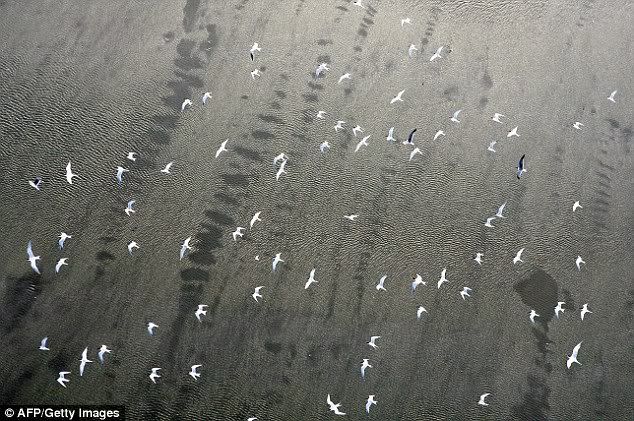
Impending danger: A Greenpeace image taken shows birds flying over the oil on the waters near Breton Sound Island in the Gulf of Mexico
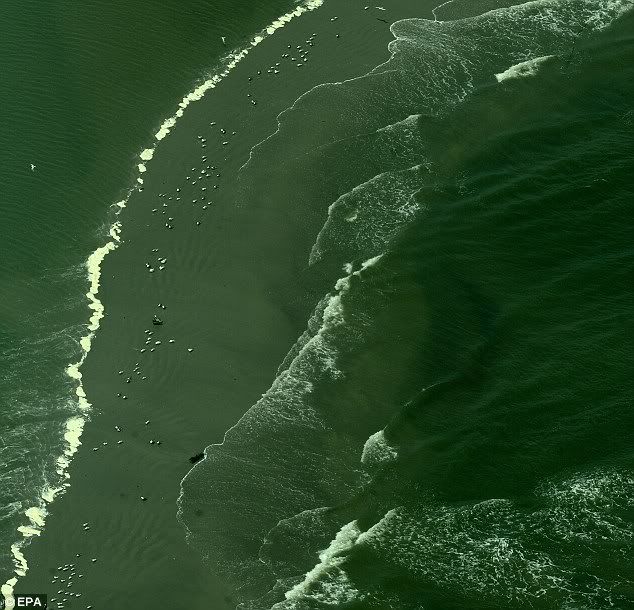
Oil slick: Birds rest on a sand bar in an area affected by leaking oil from the Deepwater Horizon drilling rig in the Gulf of Mexico
Satellite images show that by early yesterday, the slick had more than trebled in size in 24 hours, from 1,150 to 3,850 square miles, six times the area of Greater London.
More than £10billion has been wiped off the value of BP’s shares, with insiders saying that President Obama is ‘furious’ over the spillage and ‘determined’ to make the British oil giant pay.
Lawsuits filed against the company by shrimp farmers, hoteliers and ecological groups argue that the fragile Louisiana swamps will be irreparably damaged by the 11million gallons of oil that have flowed from the uncapped well 5,000 feet down on the ocean floor since the rig exploded on April 20, killing 11 workers.
The spill threatens hundreds of species of wildlife, including birds, dolphins and the fish, shrimp, oysters and crabs that make the Gulf Coast one of the nation’s most abundant sources of seafood.
The £1.5billion Louisiana seafood industry, which produces 40 per cent of America’s oysters, shrimp and crabs, has been ‘decimated’.
Yesterday President Obama was planning to head to the Gulf Coast to see first-hand the efforts to contain the massive spill. BP’s chief executive Tony Hayward was also on his way to Louisiana.
Yesterday the sea was too rough and the wind too strong to burn off the oil, suck it up effectively with skimmer vessels, or hold it in check with the miles of inflatable booms strung along the coast.
And with the wind blowing from the south, the oil slick could reach the Mississippi, Alabama and Florida coasts by tomorrow.The amount already threatens to make it the worst U.S. oil disaster since the Exxon Valdez spilled 11million gallons (42 million liters) off Alaska's shores in 1989.
'The sort of occurrence that we've seen on the Deepwater Horizon is clearly unprecedented,' said BP spokesman David Nicholas. 'It's something that we have not experienced before ... a blowout at this depth.'
In the past 24 hours, animal rescue operations ramped up, including one at Fort Jackson, about 70 miles (112 kilometers) southeast of New Orleans.
That rescue crew had its first patient, a bird covered in thick, black oil. The bird, a young northern gannet found offshore, is normally white with a yellow head.
Several miles out, the normally blue-green gulf waters were dotted with sticky, pea- to quarter-sized brown beads the consistency of tar.
High seas were forecast through Sunday and could push oil deep into the inlets, ponds, creeks and lakes that line the boot of southeastern Louisiana. With the wind blowing from the south, the mess could reach the Mississippi, Alabama and Florida coasts by Monday.
Amid increased fingerpointing, efforts sputtered to hold back the spill, while the government desperately cast about for new ideas for dealing with the growing environmental crisis. President Barack Obama halted any new offshore drilling projects unless rigs have new safeguards to prevent another disaster.
Jane Lubchenco, head of the National Oceanic and Atmospheric Administration, met with fishermen and others Friday night in Venice and said she had participated in a conference call earlier with governors from the Gulf states and BP. Stemming the flow of oil is the top priority, she said.
"There is very deep concern about what is happening," she told the group.
However, the seas were too rough and the winds too strong to burn off the oil, suck it up effectively with skimmer vessels, or hold it in check with the miles of orange and yellow inflatable booms strung along the coast.
The floating barriers broke loose in the choppy water, and waves sent oily water lapping over them.
"It just can't take the wave action," said Billy Nungesser, president of Louisiana's Plaquemines Parish
Louisiana officials opened gates in the Mississippi River hoping a flood of fresh water would drive oil away from the coast. But winds thwarted that plan, too. The Louisiana National Guard was mobilized late Friday to help communities respond to the spill and the Pentagon said BP will be required to pay the costs of deployment.
BP also sought ideas from some of its rivals and was using at least one of them Friday - applying chemicals underwater to break up the oil before it reaches the surface. That had never before been attempted at such depths.
Although the cause of the explosion was under investigation, many of the more than two dozen lawsuits filed in the wake of the explosion claim it was caused when workers for oil services contractor Halliburton Inc. improperly capped the well - a process known as cementing. Halliburton denied it.
Crews have struggled for days without success to activate the well's underwater shutoff valve using remotely operated vehicles. They also are drilling a relief well in hopes of injecting mud and concrete to seal off the leak, but that could take three months.


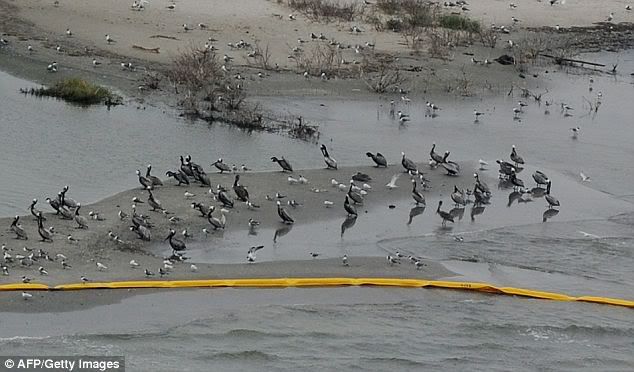



0 comments:
Post a Comment